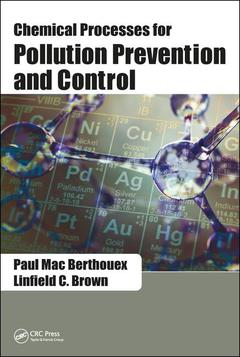Chemical Processes for Pollution Prevention and Control
Auteurs : Berthouex Paul Mac, Brown Linfield C.

This book examines how chemistry, chemical processes, and transformations are used for pollution prevention and control. Pollution prevention reduces or eliminates pollution at the source, whereas pollution control involves destroying, reducing, or managing pollutants that cannot be eliminated at the source. Applications of environmental chemistry are further illustrated by nearly 150 figures, numerous example calculations, and several case studies designed to develop analytical and problem solving skills. The book presents a variety of practical applications and is unique in its integration of pollution prevention and control, as well as air, water, and solid waste management.
The Chemical Process Design Problem. Introduction. Chemical Processes. Process Analysis. Process Synthesis. Stoichiometry. Equilibrium. Kinetics. Green Chemistry. About This Book. Pollution and Pollutants. Pollutants. Elements of Life. Aggregated or Lumped Measurements. Turbidity. Color. Particulate and Dissolved Solids. Dissolved Organic Matter (DOM) and Natural Organic Matter (NOM). Total Organic Carbon (TOC). Chemical Oxygen Demand (COD). Biochemical Oxygen Demand (BOD). Iron and Manganese. Hardness, Calcium and Magnesium. pH. Alkalinity. Nitrogen. Phosphorus. Sulfur. Toxic Metals. Conclusion. Organic Pollutants. A Brief Introduction to Naming Organic Chemicals. Hydrocarbons – The Alkanes. Hydrocarbons – The Alkenes. Hydrocarbons – The Alcohols. Organic Acids and Aldehydes. Other Classes of Organic Molecules. What Has Been Learned So Far. Aromatic Hydrocarbons – Benzene and the BTEX Chemicals. Polycyclic Aromatic Hydrocarbons (PAHs). Polychlorinated Biphenyls (PCBs). Dioxins and Furans. Pesticides. Solvents and Volatile Organic Chemicals (VOCs). Conclusion. Measuring Pollutants. The Design Problem. The Fundamental Units of Measurement. Mass Concentration – Parts per million and mg/L. Mass Percentage and Mass Fraction. Mass Flow Rates. Volume Fraction and Volume Concentration. Converting Volume and Mass Concentrations in Gases. Molar Mass and Molar Concentration. Equivalent Weights. Conclusion. Stoichiometry. The Design Problem. Elements and Compounds. Atomic and Molecular Masses. Stoichiometry. Case Study - Ammonium Sulfate Fertilizer. Empirical Chemical Formulas. Conclusion. Empirical Stoichiometry. The Design Problem. Empirical Stoichiometry by Experiment - Jar Tests. Coagulation and Flocculation. Empirical Stoichiometry – Estimating Solid Reaction Products. Case Study - Stormwater Treatment by Coagulation (Yonge 2011). Statistical Experimental Design for Jar Testing (And a Case A Study of Emulsified Oil Removal). Case Study - Decolorization Experiment (Hribernik 2009). Case Study - Ethylene Glycol Factorial Experiments (Akesrisakyl 2007). Conclusion. Chemical Equilibrium for Acids and Bases. The Design Problem. Chemical Equilibrium. Ionization of Water. pH. pH Control and Neutralization. Acid-Base Reactions. The ICE Table and Solving Equilibrium Problems. Chlorination. Carbonates and Alkalinity. Another Look at Acid-Base Equilibria Using pK Values. Conclusion. Precipitation Reactions. The Design Problem. Insoluble Compounds. Solubility Products. Inventing a Useful Precipitation Process. Precipitating Metals as Hydroxides. Precipitating Metals as Sulfides. Softening. Chemical Phosphorus Removal. Struvite Precipitation and Nutrient Recovery. Leaching Metals from Sludge. Conclusion. Oxidation–Reduction Reactions. The Design Problem. Oxidation Numbers. Oxidation- Reduction Reactions. Useful Oxidation-Reduction Reactions. Fenton’s Chemistry. Case Study: Rehabilitation of Waste Pickle Liquor. Case Study –An Integrated Acid Recovery Process. Conclusion. Green Chemistry. The Design Problem. The Principles of Green Chemistry. Types of Chemical Reactions. Measures of Reaction Efficiency. Solvents. Catalysis. Case Study – Soda Ash Production. Case Study – Red Mud. Nylon and Adipic Acid Synthesis. Conclusion. Kinetics. The Design Problem. Reaction Rates – Some Generalizations. Rates of Reaction. Rate Laws for Elementary Reactions. Temperature Dependence of Rate Coefficients. First-Order Reactions. Second-Order Reactions. Reversible Reactions. Sequential Reactions.
Paul Mac Berthouex is Emeritus Professor of civil and environmental engineering at the University of Wisconsin-Madison. He has taught a wide range of environmental engineering courses, and was twice awarded the Rudolph Hering Medal, American Society of Civil Engineers, for the most valuable contribution to the environmental branch of the engineering profession. He also served on the Government of India’s Central Pollution Control Board. He has written books on air pollution and pollution control, and has been the author or coauthor of approximately 85 articles in refereed journals.
Linfield C. Brown is Emeritus Professor of civil and environmental engineering at Tufts University. He teaches courses on water quality monitoring, water and wastewater chemistry, industrial waste treatment, and pollution prevention, and serves on the US Environmental Protection Agency’s Environmental Models Subcommittee of the Science Advisory Board. He is a Task Group Member of the American Society of Civil Engineers’ National Subcommittee on Oxygen Transfer Standards, and has served on the Editorial Board of the Journal of Hazardous Wastes and Hazardous Materials.
Date de parution : 11-2017
17.8x25.4 cm
Disponible chez l'éditeur (délai d'approvisionnement : 14 jours).
Prix indicatif 129,87 €
Ajouter au panierThèmes de Chemical Processes for Pollution Prevention and Control :
Mots-clés :
Waste Pickle Liquor; chemical process design; process synthesis; Hexafluorosilicic Acid; green chemistry; Empirical Stoichiometry; dissolved organic matter; total organic carbon; organic pollutants; hydrocarbons; polycyclic aromatic hydrocarbons (PAHs); Polychlorinated Biphenyls (PCBs); Solvents and Volatile Organic Chemicals (VOCs); Molar Mass; Balanced Stoichiometric Equation; oxidation–reduction reactions; Jar Test; Linfield C; Brown; Struvite Precipitation; Ideal Stoichiometry; Balanced Chemical Equation; Ferric Iron; Ozone Flow Rate; Internal Carbon Atom; Bod Test; Initial Dye Concentration; Bod Bottle; Ionization Constant; Adipic Acid; Red Mud; Stoichiometric AFR; Solvay Process; Volatile Solids; SS; Titration Curve; Jar Test Experiments



